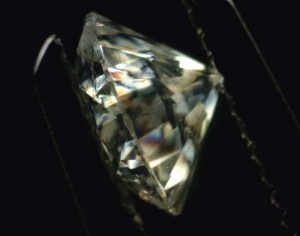Screening using optical instruments

Using cross-polarized filters (CPF) is one method wholesalers, appraisers, or retailers can use to help screen for diamond types and flag suspected synthetic stones for further testing at an advanced lab.
Diamond is an isotropic material (i.e. it displays the same properties in all directions), exhibiting birefringence, an anomalous double refraction (ADR) effect also known as ‘strain.’ This phenomenon can occur due to plastic deformation, elastic deformation near inclusions, and growth striations, among other reasons, and is manifested as an effect called ‘interference colours.’ The greater the difference between refractive indices, the more intense the interference colours appear to be. Since Type Ia diamonds have more impurities than Type IIa, their birefringence is stronger.
It is important to note birefringence is a very stable effect in diamonds and cannot be removed using currently available technologies, such as annealing, HPHT, or irradiation. The CPF method is relatively simple and inexpensive to set up, and only requires a set of linear polarization filters (or portable polariscope) attached to any microscope. To use the CPF method, position the suspected synthetic between the cross-polarized filters and rotate it in transmitted light to observe birefringence. (ADR is a 3-D effect and has to be observed from all directions).
Different diamond types and subtypes can exhibit various birefringence under CPF.
- Low-nitrogen natural diamonds often have a typical ‘tatami’ pattern (i.e. fine intersecting parallel dislocations). Type IIa brownish colour stones and Type IaB can be improved using HPHT without irradiation to colourless and near-colourless or pink. Once treated, these colours are stable.
- Though weak and difficult to observe, a ‘smudgy pattern’ is a strong indication a diamond is a natural Type IaAB (i.e. cape series), which is the most common type of near-colourless to yellow diamond. Cape samples can be colour-treated to be more intense and, therefore, more desirable.
- High pressure, high temperature is the most common method to grow synthetic diamonds—it takes two days to create a one-carat stone. Unlike natural diamonds that are exposed to pressure as they are pushed to the surface in kimberlite pipes, synthetic stones are free of the plastic deformation this process produces. Absence of any birefringence under CPF is confirmation of synthetic origin of Type Ib (yellow, pink), Type IIa diamond (colourless), and Type IIb (blue) grown using HPHT.
- Based on co-operative research between our lab and GemResearch Swisslab (GRS), we know CVD diamonds created by Scio Diamonds exhibit a ‘columnar structure’ under cross-polarized filters, as they are grown in layers on the seed. The new generation of CVD diamonds produced by Gemesis and Washington Diamonds are usually HPHT-treated to improve colour. Since these synthetics can exhibit a very weak pattern similar to natural Type IIa diamonds, additional standard (UV lamp) and advanced (photoluminescence spectroscopy) tests are necessary to confirm synthetic origin.





